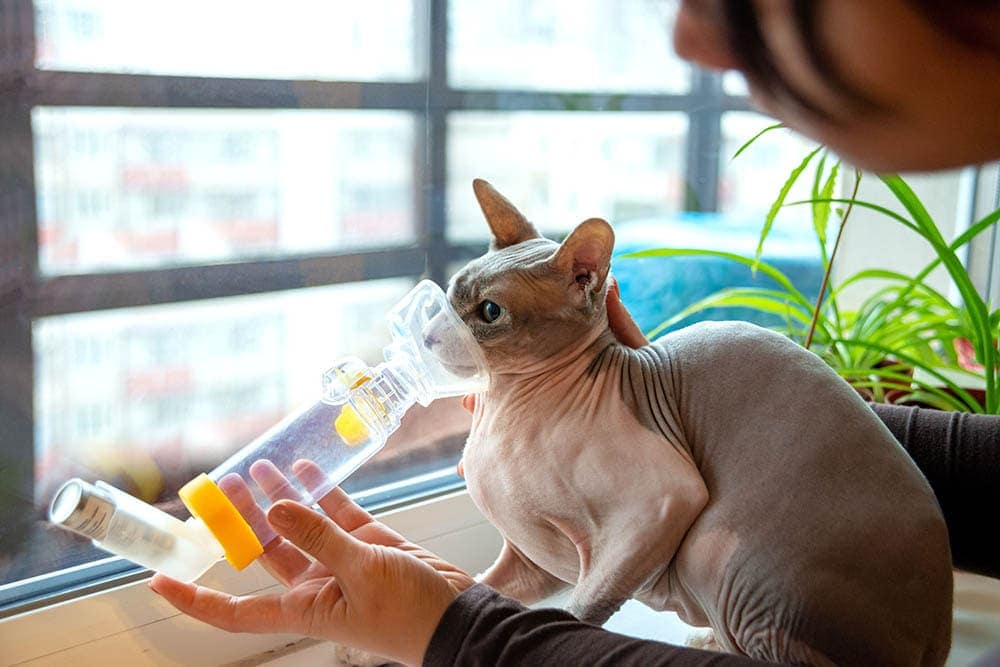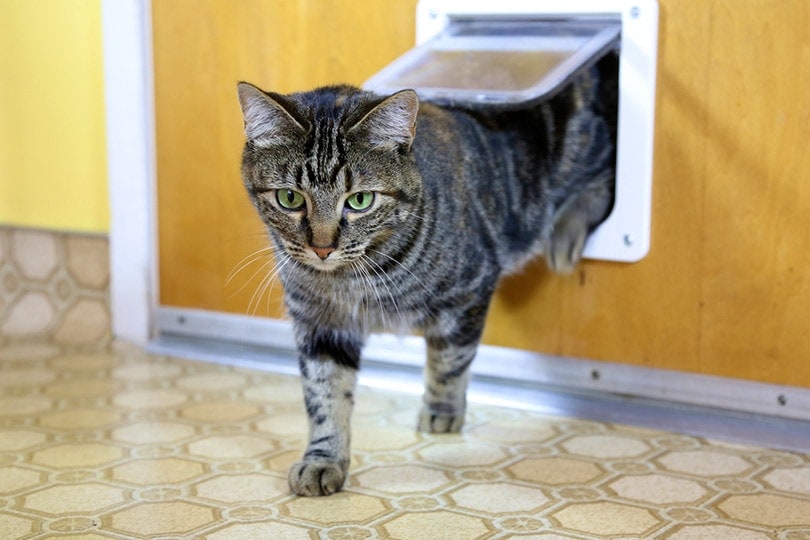How to Make a Cat Happy: 9 Simple Things You Can Do
By Ashley Bates
Updated on
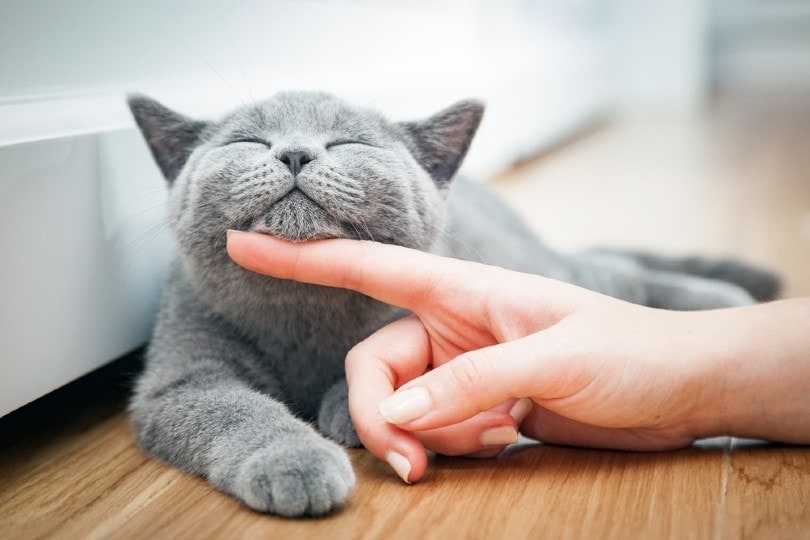
When you bring a pet into your home, their happiness is something you consider very frequently. After all, our pets make us happy, and we should always reciprocate the favor, and ensure they have the best possible quality of life. Cats are definitely unique domestic pets, requiring much different care than a dog. But what exactly makes a cat happy?
Ultimately, happiness depends on the individual cat, their overall personality, age, lifestyle, health and previous experiences. But there are some constants to consider. So, like cats have nine lives, here are nine things you can do to enrich your cat’s daily living experience.
The Top 9 Tips on How to Make a Cat Happy
1. Form a Trustworthy Bond
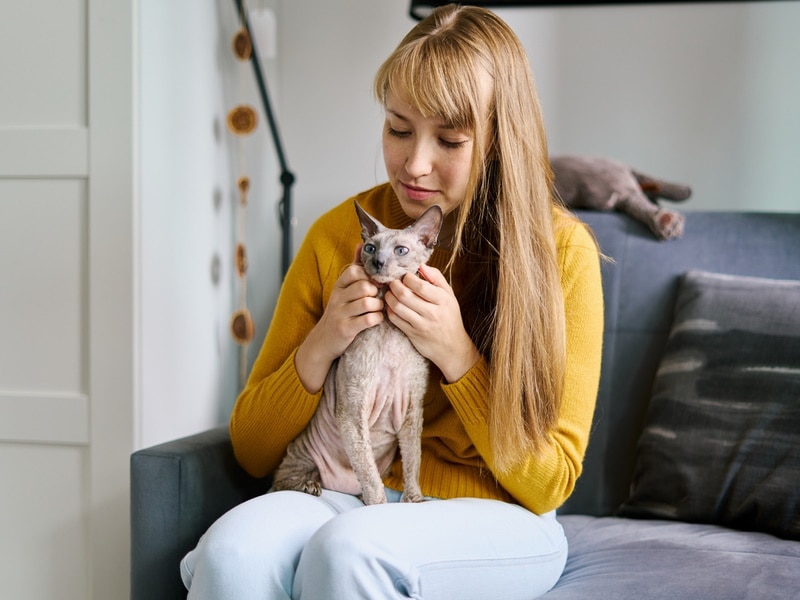
From the moment your new cat becomes a member of the family, work on forming and strengthening your bond, so they can feel safe and comfortable at all times. A cat’s need for attention varies based on their overall personality. But most cats want affection from you from time to time, even if they are slightly less social than some. The best thing you can do is get to know their overall needs and match them.
If your cat is the kind that would love to snuggle up with you on the couch, make sure you spend adequate time with them in a day to meet their needs fully. This will help the bonding experience flourish and set foundational blocks in your relationship.
If your cat loves to play, carve time every day to enjoy the fun. Your cat will love chasing a teaser, having scavenger hunts, or learning tricks – you heard that right!
On the other hand, responding to your cat with harsh words is likely to yield a poor result. Always use positive reinforcement to train your cat, teaching them the value of rewards and positive experiences. Even if you feel your cat did something unpleasant, understand that they have not done it on purpose, but as a means to communicate an underlying issue.
Observe them closely and understand their body language and their needs, while also being able to identify any stressors in their environment. Never use swatting, spraying, or yelling at your cat, as this will cause fear and stress, diminish your bond, and fail to have a positive effect.
2. Provide Daily Environmental Enrichment
Just like you would, your cat will get bored if they have to experience the same basic day repeatedly. You should always include enriching activities in your cat’s daily life. Spending lots of time with them is equally important, ensuring you interact regularly.
It would help if you had a good supply of toys and other forms of entertainment. Here are a few to mention, along with their benefits.
Toys
It’s no secret that our cats love to play. They are natural hunters, so anything that moves can trigger their prey drive. To channel this energy and instinctual behavior, it’s crucial to have a decent supply of toys. You can select both interactive and solo play toys.
- Catnip stuffies
- Jingly balls
- Ball track towers
- Tunnels
- Teasers
- Treat puzzles
You can even create some DIY cat toys at home for next to nothing. Supervise your cat during playtime, particularly if they like to chew on toys, or they are battery powered, so they would not ingest anything accidentally.
Our Favorite Cat Toys Here are a few of our favorite cat toys, each caters to various types of play your cat might like the best.
Hepper Catnip Stick
Hepper Whale Plush
Hepper Furball Set
Contains Catnip
Safe for KIttens
Self-play
All-Natural
Washable
Cat Trees
Cat trees provide a multi-purpose source of entertainment in your household. Your cats can climb, scratch, and nap all over it. You can select from multiple sizes, depending on your home space and number of cats.
Some cat trees and condos are made better than others, so always be sure to read reviews. Since these pieces can be expensive, getting a quality product is crucial. If you feel up for the challenge, you can make a well-constructed cat tree for your own home.
Scratching Posts
If you cherish your furniture at all, scratching posts are a must! You can get them very cheaply or pay a high dollar depending on the materials and quality.
- Cardboard
- Sisal rope
- Sisal fabric
- Carpet
You can have one or many of these materials to provide variety and texture to your cat.
Beds
Can you ever have enough cat beds? Rest assured, if you don’t, your cat will create spaces of their own—whether it be a laundry basket, the back of a couch, or a pillow. So, it’s best to stay ahead of the game.
- Donut-shaped
- Orthopedic
- Caves
- Teepees
- Hammocks
You can buy cat beds at virtually any department store or pet shop. You can also find an endless sea of supplies online. You can also create your cat beds out of old T-shirts and other items you might already have on hand. You can even crochet or knit a variety of patterns.
Finding a bed that your cat truly enjoys can be a challenge. Our Hepper Nest Bed features an enticing, portable design that encourages cats to explore and curl up in. Created with a comfy bowl shape to offer maximum support and a self-warming fleece insert, you’ll have a hard time getting your cat up from their daily naps.
Wall Attachments and Perches
Wall attachments and perches are becoming more and more popular for cat owners. These entertainment items for cats are designed to channel climbing instincts, and many would agree that they work! You can choose from a wide selection of options.
If you have an older cat or one that has mobility issues and doesn’t jump onto any high surfaces, you might only get a little use out of these items. But if you have a cat that needs to be on higher surfaces of the home, these attachments can benefit your household.
3. Be Mindful of Changes in Their Environment
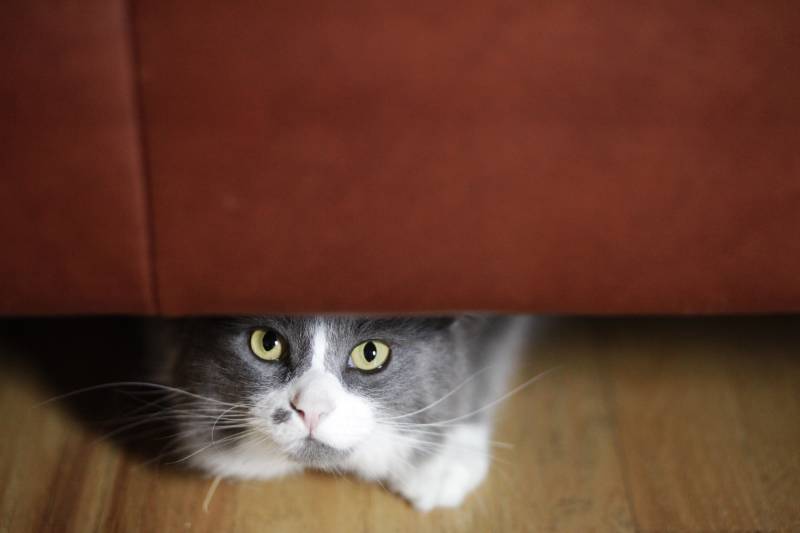
Life never stays the same. But cats are creatures of habit. If something changes drastically in the household, it can disrupt their natural patterns and throw them off. These drastic changes can result in momentary changes in behavior and trouble adjusting.
Changes are coming; you should always introduce your cat slowly to whatever new chapter is on the horizon. Make introductions with new pets and people gradually and with ease. If your cat is very stressed out, it can cause all sorts of adverse reactions and behavioral changes, like:
- Excessive vocalizations
- Destructiveness
- Aggression
- Hiding
- Eliminating outside of the litter box
- Anxiousness
- Changes in appetite
—and many more.
If you’re looking for how to make a cat happy, constantly adjust the environment based on their personality and comfort where you can help. Most cats will acclimate to new changes given the right introductions and time.
4. Make Sure Your Cat Is Fed a High Quality Diet
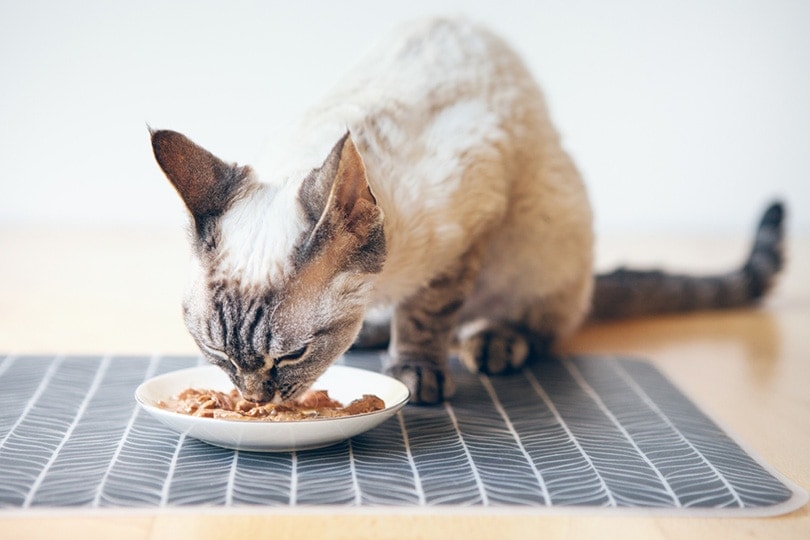
Making sure your cat is fed on time with correct portions is of utmost importance. If you have yet to refill the food bowl on time lately, you’re definitely going to hear about it. You’ll certainly hear about it if you slack in the feeding department.
Feeding appropriate portions is necessary with cats. They might act like they’re starving, but they need portion control, especially after cats get fixed; overfeeding and lack of physical activity can cause unnecessary weight gain and require frequent monitoring. There’s always a happy medium.
A proper cat diet includes a high-quality, protein-rich food source. Here are the different diet options, along with their benefits and downfalls.
Wet Canned Food
Canned food is an excellent food choice for many cats. This complete food type adds an extra kick of flavor and hydration to your cat’s diet and can be a good option for cats that don’t drink enough, or are battling low level dehydration, such as senior cats suffering with kidney disease and other chronic conditions. Some cats may require a particular prescription diet, such as a urinary diet, which will be recommended and started by the vet.
Dry Kibble
Dry kibble is the most common type of food for cats. It provides a well-rounded, species-specific selection of ingredients and has a longer shelf life. However, dry cat food does not give your cat any additional hydration, so many families add wet food as a topper.
Fresh Food
Fresh food is becoming an increasingly popular option for pet parents. Often, fresh foods come with subscription-based services where meals are tailored specifically for your cat and delivered to your door. These options can be more expensive, but they are more species-specific diets. When it comes to raw food, speak to your vet about the pros and cons of giving it to your cat, as there are certain hygienic requirements and precautions that should be taken if this is the food of choice for your cat.
Fresh Water
Always make sure you offer fresh water to your cat. Many folks find that water fountains inspire cats to drink more often. If you don’t have a fountain, make sure to change your cat’s water daily, providing clean, crisp drinking water.
5. Help Your Cat with Grooming When Required
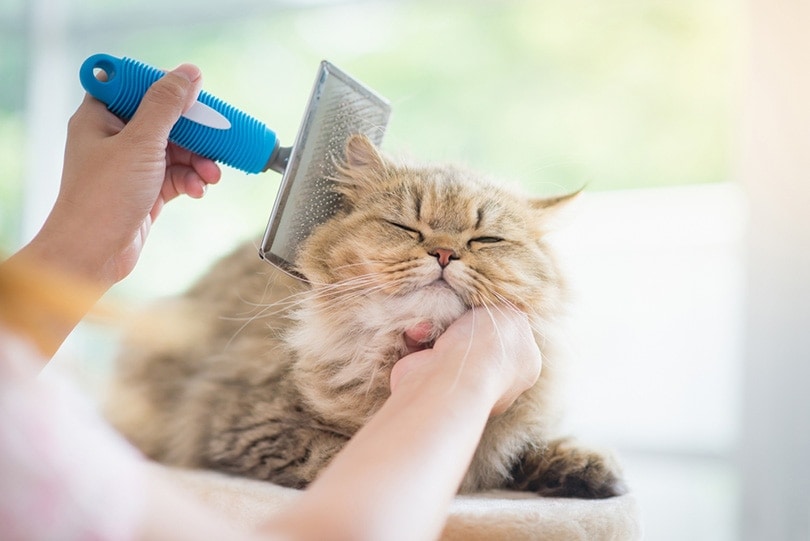
Grooming is a very important part of your cat’s day. Cats will get together to groom each other to bond and promote cleanliness. If you assist your cat with grooming, this can create a bonding experience between the two of you.
Baths
Cats do a wonderful job of grooming and cleaning themselves. And most of them hate actual baths. There is no need to bathe your cat, unless they got something sticky or potentially harmful on their fur that needs to be removed, or if instructed by your vet as part of treatment for specific skin issues, which is not very common. Bathing can cause significant stress to most felines, and if performed often it can deplete their natural oils, which leads to skin dryness and irritation.
If there is an area of the skin that your vet instructed to be bathed, do so gently and always use cat-specific and vet-approved shampoos that are formulated for felines.
Our Recommendations Adding a shampoo and conditioner duo to your pet's grooming routine could be the difference in creating a soft, fluffy coat and hydrated, nourished skin. Heppers Oatmeal Pet Shampoo gently lifts dander, dirt, and excess fur without scrubbing away the natural oils important to your cat's derma health. The Pet Conditioner restores any moisture that may have been washed away and will prevent tangles and static. Both are all natural and formulated to soothe irritated skin.
Hepper Oatmeal Pet Shampoo
Hepper Pet Conditioner
All-natural
Fresh, light scent
Cleans fur and skin
Combats tangles & static
Brushing
Many short-haired cats don’t have a problem when it comes to brushing. However, medium to long-haired cats need some help from time to time, particularly elderly cats that tend to groom less. Daily brushing prevents mats and tangles from forming in your cat’s fur.
If you need a great brush, we recommend the Hepper Cat Brush. This easy-to-use product reliably removes loose hair and knots, and you can clean it with the touch of a button! Try it and you’ll see why this brush is perfect for you and your cat.
Nail Care
We strongly discourage declawing cats, unless this is recommended by your vet due to a medical issue such as a claw tumor, large non-healing wound or other, and the claw cannot be salvaged. It is an excruciating and unnecessary process and should not be performed as an elective procedure to stop normal cat scratching behavior, as it interferes with the cat’s everyday life, instinctual behavior, comfort, and quality of life. However, you can trim your cat’s nails if you are familiar and comfortable with the procedure, or get them done at the vet or groomer if they are growing long, particularly in older cats that may be using the cat scratchers less often. Overgrown nails get stuck on fabric and clothes, but can also grow into the pads, leading to a painful wound that needs veterinary attention.
Trimming your cat's nails isn't the easiest task in the world, but a well-designed set of clippers can make all the difference. Our Hepper Cat Nail Clipper Set features two sizes of clippers with easy-to-clean stainless steel blades and a built-in safety guard to prevent accidental cuts. These clippers are comfortable to hold, nicely designed to work at tricky angles, and even include a bonus hidden nail file and a convenient pouch!
6. Be Mindful of Cat Safe and Unsafe Plants
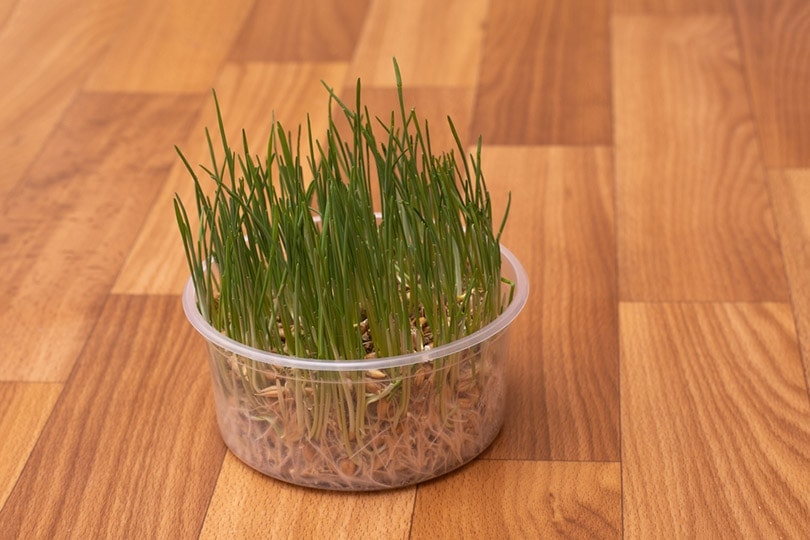
Do you have a plant chewer on your hands? If your cat can’t seem to stay out of your house plants, cat grass is an excellent solution to the problem. Familiarize yourself with the plants toxic to cats and make sure you do not keep those in the house, as the risk of your cat coming in contact with them will always be present. Cats are notorious for finding loopholes around the house and getting into rooms that should be off limits.
Cat grass provides roughage in the diet. It contains folic acid, which benefits the overall function of the body. Because of the high fiber content, it also supports the digestive tract.
The cat grass is completely safe for your feline to consume, but make sure it is not treated with any pesticides or fertilizers. Even though cats are obligate carnivores, it still provides some bodily benefits and many cats love the texture of cat grass.
Cat grass is usually comprised of common grasses like barley, oat, rye, and wheat. Usually, these pods have a combination of grasses, but some might only contain one type. Cat grass is growing in popularity. You can purchase it at virtually any pet store or online on sites like Chewy and Amazon.
7. Give Your Cat Lots of Secure Outside Places to Explore
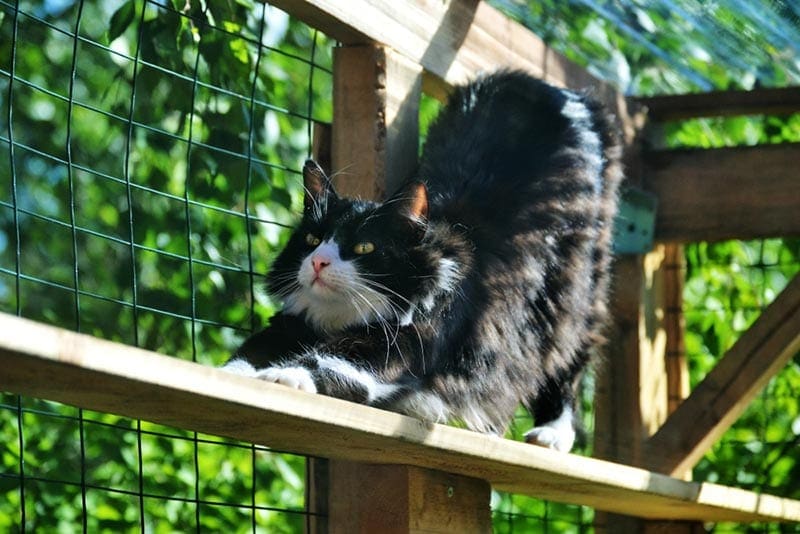
It’s no secret that our cats love the great outdoors! You can’t ever have too many comfy spots for your cat to kick back, groom themselves, and get a little shut-eye while appreciating the outside, observing birds and catching insects.
People can put cages on their windows that allow access to the outdoors. These are called cat balconies, and they’re increasingly growing in popularity. If you own your own home, you might even be able to let your cat enjoy the great outdoors without actually going outside.
Granted, an apartment complex might not be the best place to set one of these up, but in owned homes, they can be extremely beneficial. You can also build enclosed catios so your cat can go outside, smell the smells, and enjoy nature’s elements without roaming freely.
8. Have a Sufficient Number of Litter Boxes
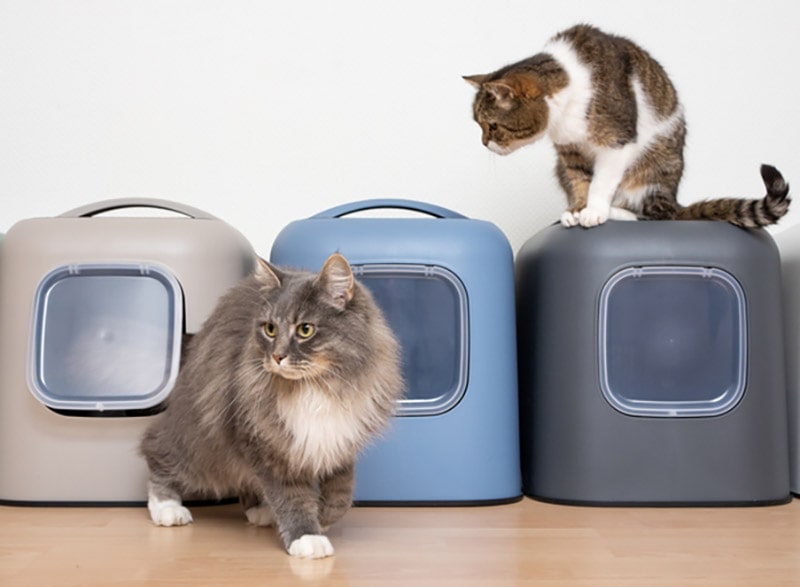
Getting to know your cat’s litter box habits can prove a little challenging at first; however, it is something that shouldn’t take a whole lot of time to figure out. Most cats prefer to have privacy, wanting a quiet room with not much chaos.
Some may prefer openness, where they can see what’s happening around them. For this reason, open-concept litter boxes might work best for them. Granted, these might require cleaning more often due to lack of smell containment.
Multiple litter boxes prevent stress and competition for resources in multi-cat homes. It also prevents household accidents. Plus, if a litter box is getting too stuffed, your cat might try to eliminate in another place in the home instead, which can be unpleasant. The general rule is one litter box per cat, plus an extra one.
Cats are very clean animals that take hygiene seriously. Some cats simply don’t like to go where another cat uses the litter box for territorial reasons as well.
Even if you only have one cat, offering multiple litter boxes will ensure your cat can go to the toilet anytime they want to, regardless of where they are in the home.
9. Keep Up With Regular Veterinary Care

Having a cat means also ensuring their health is a priority, and focusing on prevention of disease whenever possible. Consult with a veterinarian about the best products to use to protect your cat against fleas, ticks and internal parasites, and infectious diseases through regular vaccination. This is also the time your cat gets a thorough check up so your vet can make sure they are healthy.
It’s generally enough for an average young or adult cat to be checked by the vet once a year, unless there are any health concerns in the meantime. Kittens need more frequent checks so they can have their vaccinations started off appropriately, and they can be spayed or neutered to prevent unwanted pregnancies, transmission of diseases, and roaming the streets in search for a mate.
Senior and geriatric cats should be checked more often, from twice per year if they’re healthy and there are no concerns, to more frequently if they are suffering with any health issues that need regular monitoring and ongoing treatment.
Make sure to familiarize yourself with your cat’s food preferences, toileting habits, and behavior, so you can notice any subtle changes at any age that may indicate an underlying health issue.
Conclusion
Keeping your cat happy and healthy is generally an easy thing to accomplish with a little bit of dedication and patience. Giving them lots of environmental enrichment, mental stimulation, physical exercise, scratch posts, perches, and toys to play with makes a satisfied feline. Regular veterinary care is crucial in making sure they remain healthy for many years to come and protected against fleas, ticks, internal parasites, and infectious disease, and that any medical issues get picked up early on and treated adequately.
If you keep these tips on how to keep cats happy in mind, you should have very content little kitties.
Featured Image Credit: PHOTOCREO Michal Bednarek, Shutterstock










